- Trending:
- Pope Francis
- |
- Resurrection
- |
- Trump
- |
- Social Justice
- |
- Peace
- |
- Love
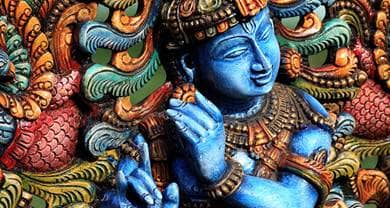
RELIGION LIBRARY
Hinduism
Symbolism
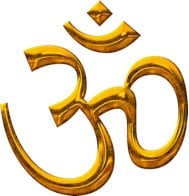 One of the most common symbols in Hinduism is the Sanskrit letter om (or aum). This is the understood not only as the first letter (or sound) of the sacred alphabet, but the first sound in the cosmos that led to creation. It is thus the first principle of the universe. There are many philosophical discussions of om; some hold that it is actually composed of three separate sounds. The first embodies the three worlds—the earth, atmosphere, and heavens; the second embodies the three great gods—Brahma, Vishnu, and Shiva; and the third, three of the Vedas—the Rig, Yajur, and Sama. Om typically begins Hindu mantras, sacred verbal formulas, and prayers, and it is often the first (and last) letter of sacred texts. Om is also used in various yogic meditational practices.
One of the most common symbols in Hinduism is the Sanskrit letter om (or aum). This is the understood not only as the first letter (or sound) of the sacred alphabet, but the first sound in the cosmos that led to creation. It is thus the first principle of the universe. There are many philosophical discussions of om; some hold that it is actually composed of three separate sounds. The first embodies the three worlds—the earth, atmosphere, and heavens; the second embodies the three great gods—Brahma, Vishnu, and Shiva; and the third, three of the Vedas—the Rig, Yajur, and Sama. Om typically begins Hindu mantras, sacred verbal formulas, and prayers, and it is often the first (and last) letter of sacred texts. Om is also used in various yogic meditational practices.
 The swastika is another common symbol. Although the Nazis appropriated this symbol in the 1920s, the swastika is an ancient Hindu symbol that denotes well-being and auspiciousness. Temples are adorned with swastikas, and it is used in a wide range of context: weddings, festivals, all manner of rituals, and to decorate everything from trucks to cakes.
The swastika is another common symbol. Although the Nazis appropriated this symbol in the 1920s, the swastika is an ancient Hindu symbol that denotes well-being and auspiciousness. Temples are adorned with swastikas, and it is used in a wide range of context: weddings, festivals, all manner of rituals, and to decorate everything from trucks to cakes.
Lotuses are ubiquitous symbols in Hinduism. Hindu gods and goddesses are typically depicted with lotuses: they sit on lotuses, they hold lotuses, sometimes they emerge from lotuses. Gods and goddesses are also described using lotus imagery: Krishna, for instance, is called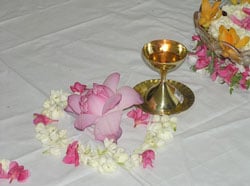 the "lotus-eyed one," and goddesses are frequently compared to lotuses. Lotuses are particularly associated with purity: although they begin in the mud, they grow up through the water and emerge on the surface. When they open, the flower is utterly cleansed.
the "lotus-eyed one," and goddesses are frequently compared to lotuses. Lotuses are particularly associated with purity: although they begin in the mud, they grow up through the water and emerge on the surface. When they open, the flower is utterly cleansed.
The lingam is a symbolic representation of the god Shiva, although it is also more than a symbol in that like other images of the gods, it is seen as an actual embodiment of the god. In other words, it is not a symbol of the god; it is the god. It is one of the most prevalent images in all of Hinduism, and can be found in almost all Shiva temples. 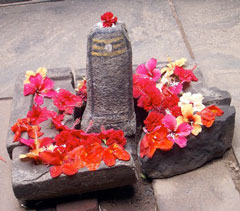 It may have its origins in the Vedas, where sacrificial posts, or stambha (or skambha), sometimes symbolized the gods, or it may have been borrowed from the Buddhists, who erected reliquaries, or stupas, to enshrine the relics of the Buddha. At any rate, the lingam is a quite complex sort of symbol.
It may have its origins in the Vedas, where sacrificial posts, or stambha (or skambha), sometimes symbolized the gods, or it may have been borrowed from the Buddhists, who erected reliquaries, or stupas, to enshrine the relics of the Buddha. At any rate, the lingam is a quite complex sort of symbol.
Some have seen the lingam as a phallic symbol, although this is a matter of significant dispute. There are myths that certainly resonate with this phallic imagery, but this does not mean that most Hindus who venerate Shiva in this form in any way associate the lingam with the phallus. Rather, the lingam is treated as an aniconic manifestation of the god. Lingams are typically human created images, but there are also important naturally occurring lingams. In cave temples in the Himalayas—Shiva's special abode—stalagmites are sometimes regarded as lingams. At Amaranath, in the Indian state of Jammu and Kashmir, there is a cave that is mythically associated with Shiva and Parvati in which an ice stalagmite forms each spring and summer and which is worshipped by pilgrims as a particularly auspicious lingam.
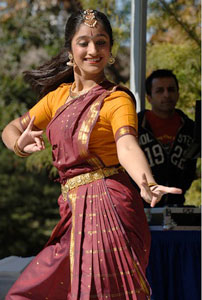 There are also all manner of symbolically significant physical acts. Mudras are symbolic bodily gestures that denote particular religious sentiments or intents. For instance, the abhaya mudra, the gesture of "no fear" made by opening the palm outward, is often displayed by gods and goddesses to symbolize their protective abilities. Mudras are very important in classical Indian dance, in which each of the gestures of the dancer has specific symbolic resonance.
There are also all manner of symbolically significant physical acts. Mudras are symbolic bodily gestures that denote particular religious sentiments or intents. For instance, the abhaya mudra, the gesture of "no fear" made by opening the palm outward, is often displayed by gods and goddesses to symbolize their protective abilities. Mudras are very important in classical Indian dance, in which each of the gestures of the dancer has specific symbolic resonance.
Many Hindus wear a symbolic mark, or tilak (in Sanskrit, literally "mark"), across their forehead. Although Sadhus (renouncers) and priests wear tilaks at all times, many people wear them only after a visit to the temple or on an important day, such as during a religious ritual or on a festival day. 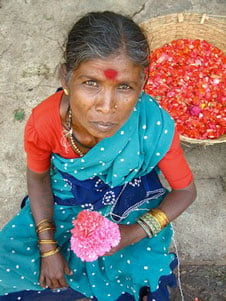 Shaiva tilaks are typically three lines—sometimes chalk or sacred ash—representing the trishula, the trident that Shiva and his ascetic followers carry. Vaishnava Hindus, likewise, wear a variety of tilaks that symbolize their chosen deity, Vishnu.
Shaiva tilaks are typically three lines—sometimes chalk or sacred ash—representing the trishula, the trident that Shiva and his ascetic followers carry. Vaishnava Hindus, likewise, wear a variety of tilaks that symbolize their chosen deity, Vishnu.
One of the most commonly performed symbolic gestures is the anjali mudra. When Hindus meet one another, they typically display the anjali mudra, placing the palms together and raising the arms and bowing, usually saying "Namaste" as they do so. This is a gesture of respect and greeting, and is done not only when two people meet, but when a worshipper approaches a god.
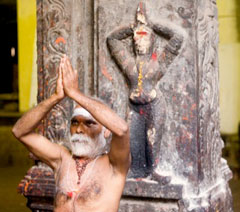
Study Questions:
1. What is om?
2. Why is the lotus used frequently in Hinduism?
3. Should the lingam be considered a Hindu symbol? Why or why not?
4. Why are hand positions considered symbolic gestures? What are some examples of mudras?










